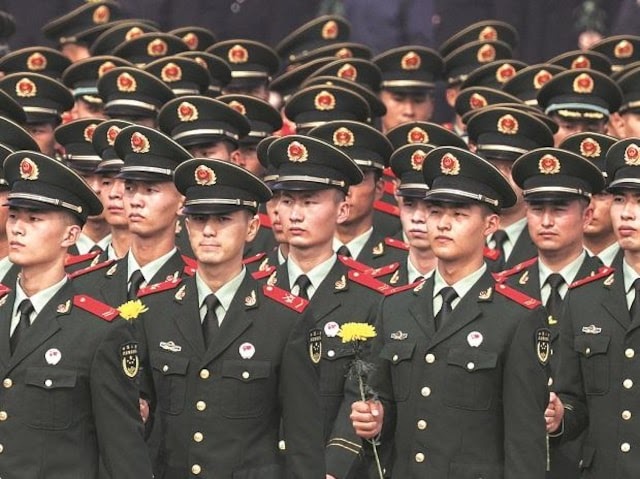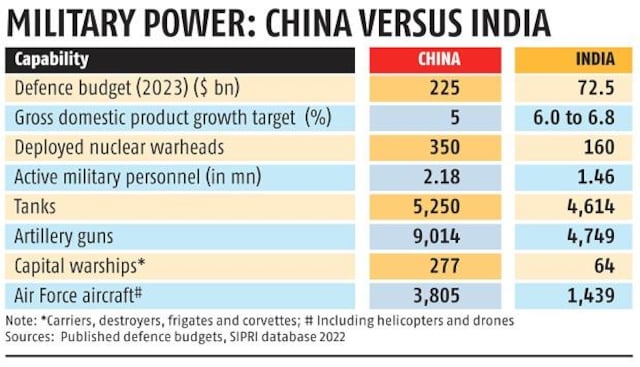
The PRC’s defense budget is three times that of India and a third of that of the United States
By Vikas Gupta
Business Norm, Mar 6, 23
The People’s Republic of China (PRC) announced its draft defense budget for 2023 on Sunday, which features a 7.2 percent increase from the 2022 budget. Beijing-based analysts called it a “reasonable and moderate”.
The 2023 budget will see China’s actual defense spending in the year rise to 1.55 trillion yuan ($225 billion), equivalent to a single-digit budget increase for the eighth consecutive year.
PRC defense spending increased by 6.6% in 2020, 6.8% in 2021 and 7.1% in 2022.
The draft defense budget was announced in a draft budget report released Sunday at the opening of the annual session of the National People’s Congress (NPC), the country’s top legislature.
The PRC aims to achieve the People’s Liberation Army (PLA) centenary goals by August 1, 2027, five years from now.
China has set a 2035 target for modernizing its national defense and armed forces.
By the middle of the 21st century, China plans to transform its military into world-class forces, Xinhua News Agencyreported on August 1, 2022, on the occasion of the 95th anniversary of the establishment of the PLA.
Analysts say the defense allocations are in line with China’s military modernization roadmap, growing security threats and optimized COVID-19 policies.
China has gradually increased its defense spending for many years, along with the country’s economic growth.
The modernization of national defense mainly consists of developing and purchasing new weapons and equipment, maintaining a high level of realistic combat-oriented exercises and improving the well-being of military personnel, an expert observed.
Many global and regional powers around the world have increased their military spending in 2023, in part due to the Russian-Ukrainian conflict.
The United States tops the list with an $817 billion military budget for the Pentagon, more than three times that of China.
Japan plans to spend $51 billion on defense, 26.3% more than the previous year’s spending.
India is increasing capital spending to $21 billion and overall defense spending by 13% to $72.5 billion. This represents 13.2% of all government expenditure, or 1.97% of India’s gross domestic product (GDP).

Other countries like the UK, France, Germany and Australia are also looking to increase defense spending, according to media reports.
In 2023, the PLA Air Force, or PLAAF, is expected to field more advanced fighter jets, including J-20 stealth fighter jets and Shenyang J-16 multirole fighter jets to replace older aircraft. Chengdu J-7 fighters that are being decommissioned.
PLA Navy set to begin sea trials of the country’s third aircraft carrier, equipped with an electromagnetic catapult Fujian. It is also expected to conduct more realistic combat-oriented exercises that consume large amounts of live ammunition and expensive fuels.
For the PRC, defense modernization has become an important issue due to what Beijing sees as a deteriorating global security situation. Besides the Russian-Ukrainian conflict and China’s support for the losing side, US House of Representatives Speaker Nancy Pelosi visited the island of Taiwan, prompting Beijing to hold a series of military exercises on a large scale around Taiwan.
The United States and its allies, including Japan, have brought the Taiwan issue to the fore. The U.S. military conducted close reconnaissance near China’s coast and transited through the South China Sea as part of “freedom of navigation patrols.”
In 2022, Japan broke with its post-WWII principle of having only defensive forces and weapons. Tokyo has started to procure offensive missiles, including US-made Tomahawk cruise missiles, which China sees as a threat.
Even so, there are apprehensions among China’s smaller Indo-Pacific neighbors about China’s aggressive stance and steady military buildup alongside its GDP growth.
For 2023, China has set its GDP growth target at around 5%. For Beijing’s neighbors, this translates into ever-increasing territorial ambitions and a growing military arsenal.






